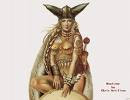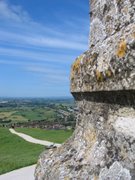Loving the Wolf
Last night was the most spectacular full moon. I lay next to the window at midnight and watched as this silver orb crossed from one side of the night sky to the other. All of a sudden I had an overwhelming urge to bay loudly. I wanted to be a wolf baying at the moon. It was a feeling of freedom and appreciation and oneness with nature. Needless to say I didn’t howl at the moon but simply chuckled at myself for feeling so at ease with my own inner wolf. :-)
Kate Histon’s beautifully expressed story about her dance teacher and the magic of her being so “hard” on her and the transformative impact of the results of that experience packs quite a punch. Childhood memories are often filled with similar stories –teacher, rugby coach – or parent. How many angry and nasty people provide the catalyst for achievement in our past? How many wolves in our history have killed off a weaker part in us and inspired new growth?
Exactly one month ago, in the August full moon, I experienced what I felt at the time was a most vicious public attack. The ‘tale’ was that I had created a situation where I perceived myself as a ‘shepherd” and yet for my attacker I was perceived as the ‘wolf”. At the time, I was dumbfounded at the attack and perception as in MY fantasy; there were only benefits for my vision and plans. For all my Demartini work, I didn’t consider the “other side”. This attack was designed to shatter my illusion of “leadership” to specifically teach me just how important it was to love being the wolf just as much as being the shepherd.
Joseph Campbell discusses his theory of the journey of the archetypal hero found in world mythologies. Campbell summarizes his theory thus: “A hero ventures forth from the world of common day into a region of supernatural wonder: fabulous forces are there encountered and a decisive victory is won: the hero comes back from this mysterious adventure with the power to bestow boons on his fellow man.”
I finally realised that in the Hero’s Journey the only part I wanted to play was the HERO. My fantasy was that all my study and development work on myself was so I could rescue, save, fight the good fight, face my demons and slay the wolf as part of my journey. When you look at popular movie culture, the Hero’s Journey is a foundation favourite. We all want to be Luke Skywalker – no one would choose to be Darth Vader!
The reality is that no matter what you do 50% of people around you will perceive you as Darth Vader even though you think you are Luke Skywalker. We can all relate to this. Who hasn’t been bitched about, back stabbed, been faced off, criticised and equilibrated by external voices? However when this happens we usually beat ourselves up saying “I must have been cocky and I deserved to be balanced in this fashion.” Or we become indignant and angry “How dare they – I’ve done so much for them!” Yet there is a very real practical purpose for us to be seen as the villain and the wolf.
Wolves play an essential role in the forest ecosystem, as necessary efficient predators. They serve an important purpose in Nature, weeding out older and sick prey which in many ways actually strengthens the overall condition of that species. They also provide a bit of a second hand smorgasbord for other animals with bits of carcass they leave behind after a hunt.
The Wolf has been portrayed in many fairy tales and myths as evil, vicious, ravenous beasts with an insatiable appetite for human flesh. Legend has it that wolves can at the right cycle of the moon possess a human soul – which I can relate to after my urge to bay at the moon last night – just like a wolf.
All cultures have myths that embody a basic belief system about nature illustrating how nature filters into human nature – Human Behaviour 101. In myth, the wolf is quite a popular character – his appearance is heavily booked! No animal has so thoroughly captured the imagination of so many cultures around the world. In European civilization, myths surrounding wolves evolved to eventually represent evil or malice. European myths and fables tend to depict fear and man’s need to conquer nature to quell this fear. The wolf is a symbol of uncontrollable nature. In many older European cultures hunting was a primary means of existence. The wolf easily became the symbol of great hunting skill and was regarded by the Celts as a companion of the Gods – critical for communication between men and god. However as European civilisation evolved away from nature and towards more controlled agriculture and industry, the wolf's reputation evolved with it until it was hunted for bounty until near extinction.
To contrast, the structure of the traditions for the North America Native cultures are in relationship to the world around them. The wolf, revered it for its great hunting prowess is seen as an intrinsic part of their every day life and was valued for its great survival, culling, teaching and healing skills. These differences demonstrate the great balance – good/evil – positive/negative.
John 10:12 describes Jesus as the shepherd protecting his herd of sheep from the wolf. Isaiah verse 11:16 "The wolf also shall dwell with the lamb." At the end of the day both the shepherd and the wolf do the same job - eat the sheep – utilse the resource – appreciate the world they live in.
I can see the value in viewing the wolf from BOTH sides of the myth.
In Fairy Tales 101, an incident occurs in childhood that is stressful – illness, death, chaos and challenge. To resolve the tension of this perceived stress, a child will create a myth using the brain’s biosurvival circuitry. Starring in the myth will be the hero the villain and the victim – usually the child -The Wolf, the Shepherd and the Sheep! The perceived Wolf - usually the parents, challenged by chaos and stress, seek to protect and shepherd and will provide sanctuary for their sheep. The perceived sheep - usually the child, may feel hunted, culled or killed by the wolf. The same event doesn’t change – only the framework of perception changes. This tale will be repeated endlessly throughout all their lives as their unconscious seeks to fill the void and resolve the tension.
In Childhood, as part of our bio survival techniques (simply because our brains have not yet the information to process events) we each craft our mythologies in this fashion using “Hero Journey” template to process the information.
For me, after my experience of being attacked and seen as a beast that needed to be hunted and killed, I see wolves as providing a necessary culling of our addiction to external praise in order to strengthen our own self species. Never underestimate the benefit of using the image of a wolf in our own Heroes journey for valuable PR. A lamb (victim) is a great marketing tool that without the threat of a wolf, doesn’t grab half as much attention!
Being a Wolf is a survival technique, serving to break addiction and dependence. A wolf is a source of healing, transition and transformation. When faced with a life-threatening situation, becoming a wolf in order to protect in order is a valid survival strategy to highly value.
So you know what? I’m happy to be seen as the wolf! After all, Romulus and Remus were rescued and protected by a wolf. Appreciating and loving the wolf within is another form of being a Shepherd. After all, just how many sheep are dressed in wolves clothing? mmm? Consider doing a TDM on Little Red Riding Hood or the Three Little Pigs and check out the wolf’s perspective?
From now on, as much as I can appreciate being a sheep and a shepherd, I also intend to howl at the moon, embrace the nature around me, value every survival strategy I have created and love the wolf!

